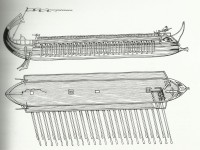By changing the attack tactics from ramming to boarding, the requirements for the ships also shifted. So the aspect of speed was shifted in favor of size. Since the technical possibilities of arranging the rudder rows were exhausted and no more ranks could be added, the rudders were simply increased and the number of rowers per rudder increased from 1 to several. Accordingly, the names of the ships were adapted to the number of oarsmen:
- One oarsman (Unireme/Monoreme)
- Two oarsman (Diere/Bireme)
- Three oarsman (Triere/Trireme)
- Four oarsman (Tetrere/Quadrireme)
- Five oarsman (Pentere/Quinquereme)
- Six oarsman (Hexereme)
- Seven oarsman (Heptereme)
- Ten oarsman (Decereme)
- Thirty oarsman (Triakontere)
- Fifty oarsman (Pentekontere)
Another change in the structure of the ships was the closed deck. So the ships could accommodate more throwing machines and marines for the entrances.
In the course of the 1st and 2nd centuries, Roman shipwrights went on to decorate towers with their deceremen. These were staffed with bows or crossbowmen and were able to inflict heavy losses on the enemy in the run-up.
Description:
Left: Serve the rudder assembly on a decereme at the 5 rowers at each rudder station
Upper right: The rudder arrangement on a trireme at the rudder station operated at each rudder station
Bottom right: Serve the rudder assembly on a quinquereme at the rower at each rudder station 2 to 3 rower
This post is also available in:
 Deutsch (German)
Deutsch (German)  Français (French)
Français (French)  Italiano (Italian)
Italiano (Italian)  简体中文 (Chinese (Simplified))
简体中文 (Chinese (Simplified))  Русский (Russian)
Русский (Russian)  Español (Spanish)
Español (Spanish)  العربية (Arabic)
العربية (Arabic)













